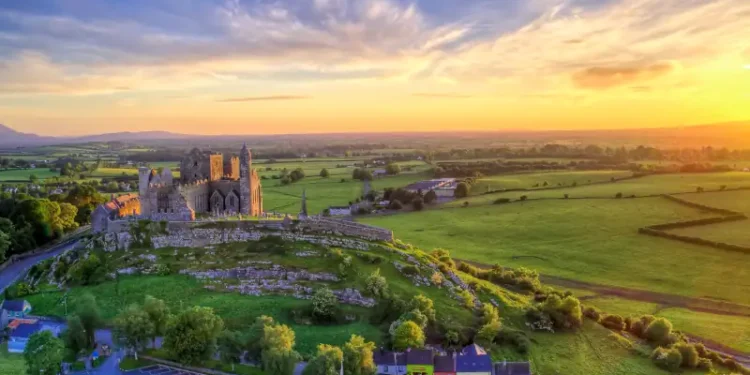John Rohan had been taking us to see houses for six months. I wouldn’t say we’d become friends or even friendly, really. The Irish were at once open, affable, hospitable, and welcoming and completely private. They’d chat your ears off for hours over pints in the pub, but, when you thought back over the conversations the next day, you’d realized that you still didn’t know anything about them.
So, while we’d spent days touring housing estate after housing estate and viewing property after property with him, we couldn’t tell you anything about the man except that he wore dark suits and was exceptional at not listening. In all the six months we’d been working with him, he’d yet to take us to see a single house that looked at all like the house I’d described for him over and over again.
I suppose we stuck with him because he was the most proactive of all the agents in Waterford City. Now that we were comfortably settled in Mark Breen’s cottage by the river, we’d lost our sense of urgency about finding a house of our own. But John kept following up, so we kept going out with him to look at more properties that didn’t fit our description of the property we wanted to buy.
Finally, our willingness to keep wasting our time paid off. His secretary called to say he would like to show us a 200-year-old stone house on seven acres 20 minutes outside Waterford City. At last. Hallelujah.
The day we went to see the house for the first time was clear and bright without a hint of Irish mist in the air. We met at his office then took off in his car, Lief up front with John, me in the back seat, enjoying the passing views.
Within minutes of leaving Waterford City, the landscape opened to a patchwork of meadows in every direction, each one a different shade of green. The fields were sprinkled with summer wildflowers.
“His daughter wanted to marry a man he didn’t approve of,’ John was saying, giving us the backstory to the house. “‘If you’ll break things off with your fellow and marry this other lad I’ve chosen for you instead,’ he told the young lady, ‘I’ll build you a country home.’ His daughter agreed, and Lord Waterford started work on Lahardan House.’
John turned off the Cork Road at the Cosy Thatch pub and traveled an even narrower lane through more heather-covered expanses. Two more right turns had us on a road barely wide enough for a single vehicle. On one side were more rolling green hills marked off into separate spaces by low stone walls and hedgerows, while the view to the right was blocked by a high wall covered with ivy.
“Here we are,’ John said, suggesting that the house we’d come to see was behind that high stone wall. This was promising, the kind of setting where you might actually find the kind of house we’d been searching for for so long.
We made a final turn onto a private dirt drive. Up ahead I could see a giant cypress tree with a massive crooked limb that would be ideal for a wooden swing. Across from it, the main event came into view as we continued down the driveway. Here, indeed, was the Irish Georgian country house we’d been scouring Waterford County for months to find.
After we’d gotten out of the car, I retreated four or five steps so I could take it all in.
With its stone walls, red Georgian front door, paned sash windows, and classic symmetry, it was my Irish country living dream come to life.
Beyond the house was an assortment of tumble-down outbuildings of stone and wood, including old stables nearly hidden by the overgrown brush and brambles.
All around, as far as I could see in every direction, were more rolling fields marked off by more low stone walls and tidy hedgerows. Not another house in sight. The only sound was the chatter of birds nesting in the enormous ash tree behind the house.
Prickly vines and nettles covered the ground around the house all the way up to the stone walls, but we wanted to see all four sides so stomped through. I was glad I’d worn knee-high boots. John unlocked the front door and led us inside.
Lord Waterford had built his daughter a fine place. Its front hall led to a winding central staircase. To the right of the hall was the living room with wide plank floors, two marble-mantled fireplaces, French doors to the side terrace, and oversized double-hung sash paneled windows with their original wooden shutters. I walked to the nearest one and pulled on the shutters to see if I could close them. I nearly giggled out loud when I found that they worked. They almost never do in a house this old. Two chandeliers hung from ceiling roses, and dentil molding outlined the room at the ceiling line. I was so excited I felt almost drunk.
We’d entered the living room from the entry hall but exited through the door at the other end, then followed the back hallway past more of those beautiful paneled windows to the kitchen. The original kitchen had been torn out, so this room was bare walls, stone floor, and empty save a giant green cast-iron oven.
“Is that an Aga?’ I asked.
“No,’ John Rohan said more sharply than I’d heard him speak before. “That is a Stanley, made here in Waterford and generally considered superior to the English Aga.’ Ah. I see.
Through the big bay window at the other end of the kitchen we could see the front drive and the fields beyond. We left the kitchen through the door to the dining room then continued back to the front hall and up the stairs. At the top was a large landing with another set of paneled shuttered windows. To either side were bedrooms with en-suite bathrooms. Turning down the hall to the right we passed three more bedrooms and the final bathroom. At the end of the hall was a door to a rooftop terrace over the utility room off the kitchen below.
Through every window along the way we had more views of Lahardan’s rolling green acres. I wanted to skip. I wanted to sing. And Lief—the master at keeping his feelings to himself when viewing real estate—kept catching my eye and smiling.
By the time we’d made our way back down the stairs and out the red front door, I was all in on this Lahardan House. The French refer to it as a coup de coeur—a blow to the heart that tells you something is meant to be. I’d known even before stepping inside that Lahardan House was our Irish home.
While he’d chatted the entire drive out from the city, on the way back to Waterford John Rohan barely spoke. I was left with only my own imagination to occupy my thoughts. The spell Lahardan House had cast over me didn’t break until we were nearly back in the city. By that time, I’d already decorated and furnished Lahardan’s living and dining rooms and was wondering what color to paint the walls in Kaitlin’s bedroom. Hers would be the next-to-last one down the hall. It had some of the best views.
John dropped us at the end of the lane to Mark Breen’s cottage. In his typically Irish estate agent way, he made no hard sell. “Give me a ring if you have any questions,’ he said.
“What did you think?’ I asked Lief as soon as John had driven away.
“What did you think?’ Lief asked back.
“I think it’s exactly the property I’ve been looking for all these months,’ I said.
“I think so, too,’ Lief said.
Walking down the lane to our little rental, I wondered what our next step would be. Lief interrupted my thoughts, as if reading my mind. “Do you remember that lawyer we met with when we had the idea to buy that house at auction?’ he asked. “I think her name was Morette something? On Parnell Street? Let’s get back in touch with her. We’ll need an attorney to help us make an offer.’
I took Lief’s hand, stepped in front of him, and pulled myself up to kiss him on the cheek.
“I think we’ve found our new home, dear,’ I said, practically bursting with joy.
Lief smiled more brightly than I’d ever seen and kissed me, too.
Until next time,

Founding Publisher, Overseas Opportunity Letter











